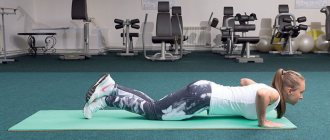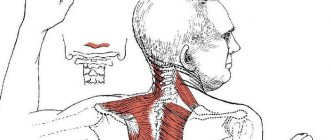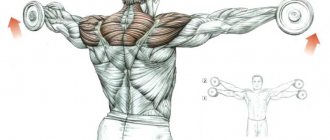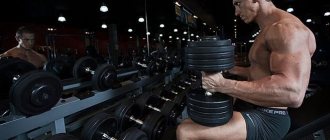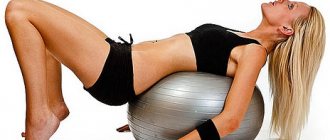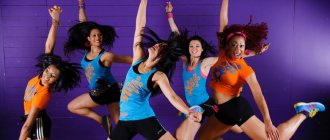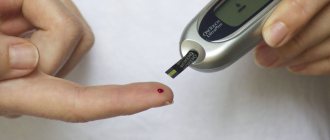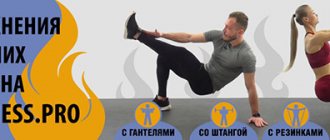A muscle corset is a muscular layer of the human body that preserves and protects the integrity of the bone structure of the spine. The main role of the bony structure of the spine is to protect an important part of the central nervous system of the spinal cord.
Dear friends! Strengthen your muscle corset and you can maintain the integrity of the bony structure of the spine, which contains the spinal cord. With the help of therapeutic and preventive physical exercises, anyone can do this.
Muscle corset is a balance of symmetrical muscles
Over many years of working with people, I can roughly divide people into two categories.
The first category is people who simply do not pay attention to their weak muscle corset, their poor posture and stoop. Looking at themselves in the mirror, for some reason they stubbornly do not notice that they have one shoulder lower than the other. People simply do not understand and underestimate the serious consequences of these abnormalities until back pain occurs.
A muscle corset is a BALANCE of the strength of the symmetrical muscles of the human body, it is a natural muscular protection and support for the spine of an upright person. The lack of protection and support from the passive bone structure of the spine is a deviation from the norm! which will inevitably lead to its curvature and the acquisition of spinal diseases.
The second category of people know that they have scoliosis or kyphosis since school, but for some reason they take it for granted and do nothing. They continue to ignore the discomfort and fatigue that appears in their back when sitting for a long time and naively hope that it will go away on its own. But it won’t go away on its own!
Discomfort and rapid fatigue of the back are the first signs of disorders with which the spine tries to remind a person of an existing problem. The appearance of these symptoms should alert people and motivate them to take preventive measures. But, alas, many people do not act!
Lack of muscle corset leads to illness
You can, of course, relieve the spine from the vertical load and lie on the couch longer... But this does not eliminate the problem. It is important to understand that you have weak skeletal muscles, which is why your back gets tired. When the spine is curvature, the vertebral bodies are crooked, so the ligaments are strained, the spinal nerves and blood vessels are pinched, hence the back pain. Failure to understand that discomfort and fatigue will not go away and will inevitably lead to the destruction of the spinal structures. This is a direct path to chronic diseases of the spine such as: osteochondrosis, spondyloarthrosis, spondylolisthesis, disc herniation, etc. These diseases lead to loss of motor abilities and disability.
There is another category of people and another extreme. Knowing about the presence of an intervertebral hernia and even experiencing back pain, people go to the gym to “pull iron” and stubbornly pump up their back. By pumping up your back and ignoring other important muscle groups, you thereby increase the IMBALANCE of symmetrical muscles. By incorrect actions, people repeatedly increase one-sided pressure and create the preconditions for the protrusion of a herniated disc. And when they pick up weights, they simply flatten their already deformed discs.
Taking into account all the mistakes people make, it is necessary to return muscular BALANCE to the body, to form a muscular corset for the spine, consisting of 4 muscle walls of the same STRENGTH. This requires deep knowledge of the biomechanics of the human body and a highly qualified trainer, and not a gym instructor focused only on muscle definition.
Many people simply do not fully understand that by continuing to mindlessly lift weights, for example: squatting with a barbell on their shoulders, their discs can simply rupture, and then they risk losing their motor abilities overnight!
These people are disoriented; they have been given the very correct idea that the spine needs protection and support in the form of a muscular corset. But no one explained how to correctly and safely form a muscular corset for the spine. How to technically correctly perform and what kind of exercises should be done to strengthen the muscle corset, so as not to harm or worsen the condition of an already damaged spine. Unfortunately, all their efforts come down to the formation of muscle definition and increasing their volume, but not to the harmonious development of symmetrical muscles of the torso. Unfortunately, there are very few specialists with sufficient knowledge of biomechanics.
Spinal diseases practically do not threaten a person’s life, and he can live immobilized for a long time, suffering from unbearable back pain. With the loss of motor abilities, a person’s life changes radically, a favorite profession is lost, a loved one leaves, they become a burden for family and friends...
Spinal diseases deprive a person of the joy of movement and many other joys of life, condemning a person to suffer from pain until the end of his days, to live in a wheelchair, to a monotonous panorama of his own apartment, to the view from the window, and sometimes only to the view of the ceiling above the bed. Here, the popular saying “Until thunder strikes, a man will not cross himself” is very appropriate. More and more in Russia, and throughout the world, the number of wheelchair users is growing; previously, residential buildings did not even have ramps (slides for wheelchairs), because paralysis occurred in the rarest cases, and even then, only with old people or -for an accident. Today people naively continue to believe that paralysis can happen to one of their neighbors, in the family of friends or in the family of distant relatives, but this will never happen to them!
Which gymnastics to choose for the back and neck?
The exercises should focus on stretching and opening the front of the body, chest and neck, as well as strengthening the upper back and neck.
Stretching and opening the chest
The exercise is usually performed on a fitball, but at home a regular pillow will do. Lie on the floor, place a pillow under your back at chest level, place your hands behind your head, relax your whole body, breathe deeply. Hold the position for 1-2 minutes. When lifting, be sure to hold on with your hands and strain your abdominal muscles. The thoracic spine must remain flexible to avoid osteochondrosis.
Chest stretch at the door
The muscle mass of the chest and shoulders is tightened and compressed while driving or working at the computer.
- To stretch it, you need to stand in the doorway, resting your arms bent at the elbows on the door frame, and hang under the force of gravity.
- Hold the position for 10 deep breaths, trying to relax your chest and shoulders more with each breath.
Posture correction
- Corrective wall exercise will correct a body that is accustomed to holding its head forward.
- Stand with your back to the wall, rest your head, buttocks and shoulder blades against it. Lightly press your chin.
- If there is a feeling of falling backwards, it means that the neck muscles are under stress, and the nervous system is being retrained to the correct position.
- Stand in this position for a minute, breathe slowly, repeat 2-3 times a day.
Butterfly exercise
- Stretching the upper back is necessary to relieve pain. You need to sit down and place your feet on the floor.
- Raise your arms, bend your elbows, and clasp your shoulders with your palms.
- Keep your back straight, tilt your head forward, join your hands in front of your face and hold for three seconds. Return to starting position, repeat 10 times.
Rolling on your head
Helps relax and strengthen the upper back and collar area.
- Sit up straight, place your hands on your knees.
- Slowly lower your chin to your chest, take a deep breath and focus on relaxing your neck.
- Slowly rotate your head to the left so that your left ear approaches your left shoulder. Hold the position for three seconds, then turn your face towards the ceiling. Repeat the movement to the right.
Shrugs
- A simple exercise can be done even at your desk or on the couch at home.
- Sit up straight, relax your arms at your sides.
- Take a deep breath and focus on relaxing your shoulder girdle.
- Shrug your shoulders, raising them as high as possible.
- Hold the tension at the top point for 5-10 seconds.
- Relax, letting your arms fall down. Repeat 10 times.
Back stand against the wall
- To strengthen your neck muscles, you need to stand with your back to the wall and rest your head against it.
- Relax your shoulders, let your arms hang freely at your sides.
- Using the strength of your neck, move your body away from the wall - push it with the back of your head.
- Hold the position for 10-15 seconds, then relax.
- Repeat 2-3 times to strengthen muscles.
Gymnastics for mobilizing the thoracic region
- Wrap two shady balls with electrical tape and place them on the floor.
- Lie with your back down so that the balls are on both sides of your spine.
- Bend your knees, place your feet on the floor.
- Bend your elbows and assume a prayer position, straightening your shoulder blades and passing the balls directly to the muscles of your upper back.
- Press the balls with your whole body so that your body forms a deflection.
- Press your lower back to the floor, tighten your abs and slightly raise your upper body.
- Move your pelvis down and lie down again, stretching your spine - the balls will be a little higher.
- Continue crawling until the balls travel from the distance at the level of the navel to the top of the shoulder blades.
Turns on all fours
- Get on all fours.
- Bend your left arm at the elbow and place it on the back of your head.
- Turn your body to the right so that your left elbow reaches your right supporting arm.
- Return to the starting position, expanding the chest.
- Try to perform the movement using your back, fixing your hips in place. Repeat 10 times, gradually increasing the range of movements.
- Try not to rotate your hips; all movements should be performed by the middle part of your back.
How to properly strengthen your muscle corset
I advise you to go to the mirror today, analyze your posture and the sensations in your back, and, finally, start taking care of your own spine, start regularly doing correct and safe exercises.
You can strengthen the muscular corset of the spine only by doing technically correct physical exercises LYING, with complete unloading of the spine.
The muscle corset should consist of 4 EQUALLY strong muscle walls, namely, the abdominal muscles, the back muscles and the muscles of the 2 lateral surfaces of the torso.
You can’t only pump up your back and abdominal muscles, and ignore the lateral muscles of the torso. When the strength of the lateral muscles of the trunk lags, scoliosis usually develops. Few people know that muscle mass should make up 40% of body weight, more is possible, but not less. Remember!
The spine is healthy only when it is surrounded by strong muscles, elastic ligaments and its joints are mobile. A MUSCLE CORSET FOR THE SPINE IS A GUARANTEE OF ITS HEALTH!
All the necessary therapeutic and preventive sets of exercises have long been released especially for you. Order complexes in the website catalog. Read the contents of the complexes carefully!
A set of exercises to strengthen your back muscles at home
Four simple exercises, which do not require equipment or practical skills, when performed regularly will help create reliable muscular support for the spinal column:
- Bridge with hips. The element is performed from the starting position lying down, with bent legs resting the feet on the floor, arms located along the torso. Exhaling, raise your hips up until your body straightens at the hip joints, linger a little at the top point and smoothly lower your pelvis. It is advisable to perform the exercise at least 15 times. As your muscles strengthen, you can increase the load by straightening one leg at the knee while lifting your hips.
- “Bird and Dog” is an interesting and effective exercise for all groups of spinal muscles. Standing on all fours (dog pose), you need to tighten your abs and straighten your back. The transition to bird pose involves simultaneously raising the right arm and the opposite (left) leg upward. At the same time, the limbs are straightened, positioned strictly horizontally and fixed for a couple of seconds. After returning to the original position, the opposite arm and leg work (do at least 5 times for each side).
- The side plank is especially useful for long-term static loads on the spine (standing work). Lying on your side and leaning on the elbow of one hand, place the other on your waist. Then lift your hips off the surface and straighten your body, fixating in this position for at least half a minute. Repeat the element for the other side. To complicate the task, you can raise your leg while doing it or lean on the palm of your straight hand.
- Lunges designed to improve coordination are performed from a standing position. Having fixed your palms at your waist, you need to step forward quite widely, bending your legs at the knee joints at a right angle. Do 10 repetitions for each leg. You can increase the load with the help of weights (hold dumbbells in your hands).
In addition to preventing deformities and diseases of the spine, this simple set of exercises will ensure excellent posture. A thin waist and graceful gait will be another pleasant bonus.

